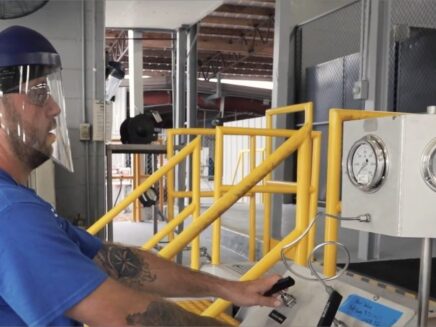Pressured systems require testing before being newly operational or after a downtime. Non-destructive tests like Pneumatic and Hydrostatic Tests are used to validate such pressurized assemblies and components before they can be functional.
PFC regularly and efficiently performs Pneumatic and Hydrostatic tests of such pressurized systems. These tests are performed on piping and tubing assemblies, valves, gauges, gas cylinders, and other pressure vessels.
It is important to note that these tests are not performed during normal operations, and they also can monitor an already tested system. They only apply to non-operational assemblies and systems.
What is Hydrostatic Testing?
Hydrostatic or Hydro Testing is a process that uses liquid to pressurized an item for strength and leaks. After shutdown and repairs, a Hydrostatic test is often required to validate that the equipment is prepared to operate under desired conditions once it is returned to service.
Test Process
A hydrostatic test involves filling an item (component, piping or tanks) with a liquid removing the air contained within it, and then pressurizing the system up to 1.5 times the design pressure limit of the unit. The pressure is held for a particular duration, and then the next step is visual observation. A drop in pressure indicates that there is a leak.
Also, the visual inspection is often enhanced by applying a tracer or fluorescent dye to the liquid to identify cracks and leaks effectively.
A hydrostatic test will expose leak points and notifies about internal or external structural problems with the tank (such as cracks) that might lead to leaks later on.
Standard Testing Procedures
The 3 widely used hydrostatic testing techniques are CGA, DOT, and ISO 14644-12. CGA is the prime preference in most cases, followed by DOT and then ISO 14644-12.
- CGA (Compressed Gas Association) tests are fast and easy to perform, making them an excellent choice for minor repairs such as oil leaks or hoses that require inspection before they can be used again.
- DOT (Department of Transportation) testing involves a relatively thorough evaluation, determines permanent expansion on vessels and requires specialized equipment.
- ISO (International Organization for Standardization) 14644-12 test methods are costly as they require expensive machines to complete the test. It involves running a device with an in-line leak detector and pressure sensors that determine the quality of your seals.
What is Pneumatic Testing?
A pneumatic test uses air, or an inert gas such as nitrogen, to pressurize the system to 110% of its original pressure limit. Then, a holding period is applied for a fixed duration, and the results are monitored to determine the safety and integrity of the system.
A pneumatic test determines the safety capabilities of a pressured system by detecting leaks, understanding maximum capacity, and testing Joint fittings.
Why is a Pneumatic Test required?
Pneumatic tests are necessary to ensure your pressure system's safety, reliability, and leak tightness. So, when a newly installed or repaired pressure system is about to be operational again, a pneumatic test is performed to validate the systems' safety and reliability.
The test also helps understand the limits and capabilities of a pressured system, which are crucial to know before putting any piping into service.
And quite understandably, the test also helps to know that your equipment meets industry qualifications or not.
Pneumatic and Hydrostatic Testing: What to prefer?
Pressure tests are mandatory for validating the integrity and safety of pressured systems. While both hydrostatic and pneumatic tests work on the same principle, hydrostatic testing is always preferred first.
Pneumatic testing poses a threat if the pressure is not efficiently controlled. While hydrostatic test uses water or a liquid, the gas in pneumatic testing can be 200 times more potent for the same volume and pressure conditions.
With such higher stored energy levels, the gas from pneumatic testing is more likely to cause damage if mishandled.
Therefore, besides being easy and more accurate, industry standards require contractors to consider hydrostatic testing before proceeding with pneumatic testing.
However, pneumatic testing becomes the only choice in certain conditions such as:
- When pressure systems cannot be filled with water.
- When water traces can't be tolerated when the system is functional again.
- When a piping system carries gas and can't contain the heavy mass of water or any other liquid.
PFC – Testing Experts
Precision Fabricating and Cleaning has nearly six decades of experience in testing various materials and pressured piping, tubing, valves, and vessels. Our facilities and experienced personnel are capable of handling Pneumatic and Hydrostatic tests up to 30,000 psi.
Our entire workforce is highly trained, understands the importance of accurate testing for safe operations, and performs tests according to CGA, ISO, ASME, ASTM, SAE, and other industry standards.

